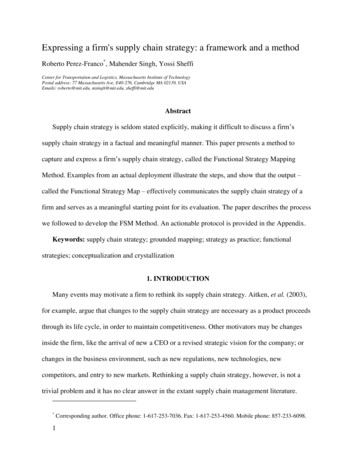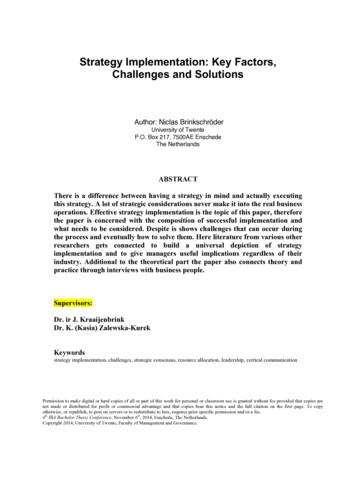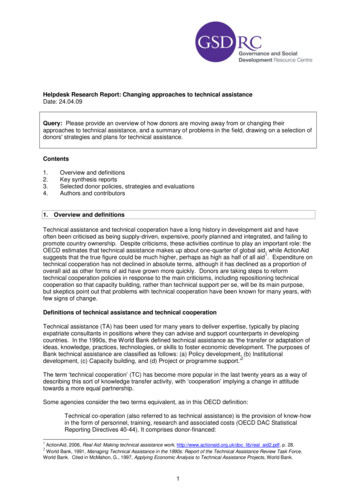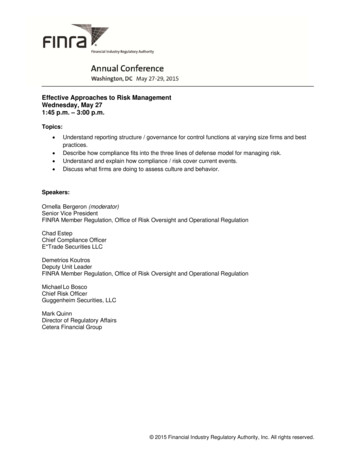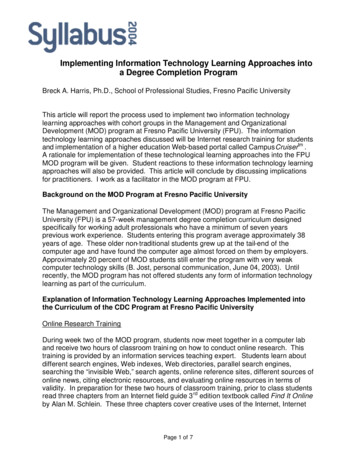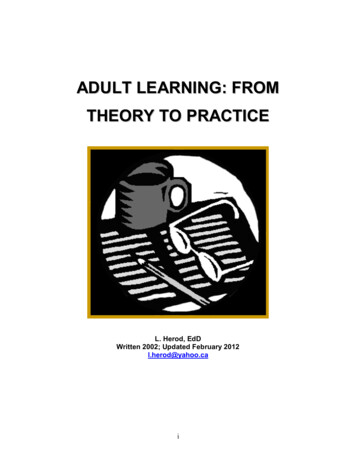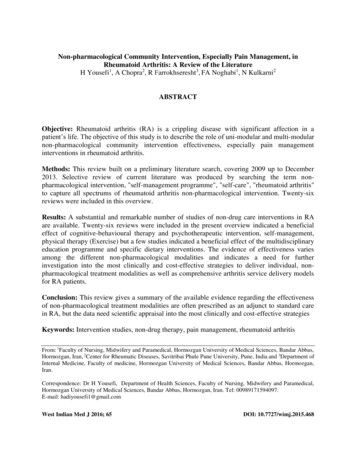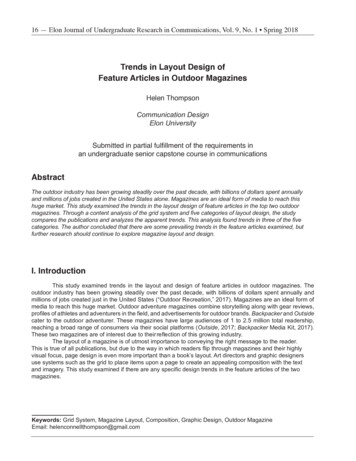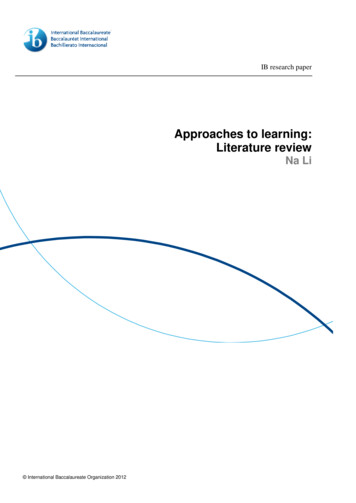
Transcription
IB research paperApproaches to learning:Literature reviewNa Li1InternationalBaccalaureateOrganization2012 InternationalBaccalaureateOrganization2010interim objectivesLanguageA teacher supportmaterial:Example
ContentsExecutive Summary.1Introduction . 1Method. 1Overview of This Literature Review . 21. “Approaches to Learning” Related Theories .41.1. Emerging Educational Objectives. 41.1.1. Multiple Intelligence Theories. . 41.1.2. Critical thinking. . 41.1.3. Creative thinking skills. . 51.1.4. Metacognitive and self-regulation skills. . 51.1.5. Affective, social skills. . 51.2. Major Perspectives of Learning and Instruction . 51.2.1. Constructivist perspectives of learning. . 51.2.2. Student-Centred learning and instruction. . 51.2.3. Technology enhanced learning and instruction. . 51.3. Summary . 62. Implementation of Constructivist and Student-Centred Learning Approaches .62.1. Curriculum, Pedagogy and Assessment: From Cognitive and MetacognitivePerspectives . 62.1.1. Inquiry-based learning. . 62.1.2. Problem-based learning. . 72.1.3. Situated and embodied cognition model. . 82.1.4. Self-regulated learning. 92.1.5. Cognitive apprenticeship model. . 10
2.1.6. Effective collaborative learning. . 102.1.7. Integrative approach of curriculum design. . 112.1.8. Summary . 112.2. Curriculum Design & Pedagogy: from Affective, Sociocultual Perspectives . 122.2.1. Addressing students’ motivation in the classroom. . 122.2.2. Establish self-relevance in the curriculum. . 132.2.3. Establish positive teacher-student relationship. . 132.2.4. Summary . 132.3. Contemporary Views of Assessment: Assessment for Learning. 142.3.1. Delineate achievement criteria and write clear learning outcomestatements. . 142.3.2. Differentiated Assessment. 152.3.4. Summary . 162.4. Summarize Major Challenges in Implementing Student-Centred LearningApproaches . 162.5. Some Suggestions Addressing the Challenges. 172.5.1. Construct a clear framework of goals and case-based description of thelearning models. . 172.5.2. Account for individual differences and cultural diversity. . 172.5.3. Align assessment with the constructive, student-centred learning models. 172.5.4. Collaborative inquiry models for professional development. . 182.6. Summary . 183. Age Appropriateness Addressed in the Implementation of Student-Centred LearningApproaches . 193.1. Cognitive, Social-cognitive, Affective Development. . 193.1.1. Piaget’s cognitive development theories and its implications. . 193.1.2.Vygotsky’s sociocultual theory of development and its implications. . 20
3.1.3.The development of social cognitive skills and affective skills. . 213.2. Implications from the Developmental Theories on Curriculum, Pedagogy andAssessment . 233.2.1. Developmentally appropriate curriculum. . 233.2.2. Developmentally appropriate pedagogy and instruction. . 233.2.3. Guided participatory curriculum at elementary level: A balance betweenstudent Initiated activities and teacher’s intervention. . 243.2.4. The role of content knowledge in student-centred curriculum andpedagogy. . 243.2.5. Age appropriate assessment. . 253.3. Summary . 264. Concluding Remarks: Implications for the IB’s Three Program and Program Transition. 274.1. Problems in the Transition across the Three IB programs . 274.2. Potential Strategies Facilitating PYP-MYP-DP Transition: More Action ResearchNeeded . 294.2.1. Coherence and consistency of curriculum objectives and standardsacross PYP-MYP-DP. . 294.2.2. Alignment of pedagogy. 304.2.3. Aligned Assessment Approaches in PYP-MYP-DP. . 314.2.4. Special Transitional Programs & Teacher Training . 325. Summary: Limitations & Suggestions for Future Research . 32References . 34Appendix A. General guidelines and implementation examples in US common core,European framework, Hong Kong Curriculum Development Council . 43Appendix B. Inquiry-based Learning Approach Examples----An Inquiry Cycle . 44
Approaches to learning: Literature reviewExecutive summaryIntroductionThe International Baccalaureate’s (IB) major objectives are “to develop inquiring, knowledgeable and caringyoung people who help to create a better and more peaceful world through intercultural understanding andrespect” and “to encourage students to become active, compassionate and lifelong learners” (IB 2008). Toalign with these goals, it is essential to implement student-centred and constructivist learning approachessupporting “whole-person” development.Over the last decade, there has been a rapid growth in the number of schools offering the IB’s fourprogrammes throughout the world (Hallinger, Lee and Walker 2011). The four IB programmes—the PrimaryYears Programme (PYP, 3–12 years), the Middle Years Programme (MYP, 11–16 years) and the DiplomaProgramme (DP) and Career-related Certificate (IBCC) (16–19 years)—were established at different timeswithout much inter-programme linkage. The DP was first established in the 1960s, the PYP and the MYP wereestablished in the 1990s, and the IBCC was introduced in 2011. It should be noted that because the IB hasonly just introduced the IBCC, it is not discussed in this paper. The three traditional programmes (PYP, MYPand DP) have different structures and are self-contained, which makes it difficult to make a smooth transitionacross programmes (Bunnell 2011). For a “continuum of international education”, the question of how to designaligned curriculum, pedagogy and assessment across different developmental stages needs to be answered.Cross-cultural differences are another important issue to be addressed in implementing various student-centredlearning approaches, as well as in the programme transition.Based on these important issues for the development of the IB, four research questions are delineated anddiscussed in this literature review. This literature review includes four major parts, and each addresses oneresearch question (RQ).RQ1: How are “approaches to learning” related theories and practices perceived and outlined in the curriculumof various national and international educational systems? What are their commonalities in terms of goals,objectives, components and other considerations?RQ2: How are these perspectives unpacked and implemented in practice, for example, integration with theschool-based curriculum, pedagogical strategies and inclusion in teacher training?RQ3: How is the issue of age-appropriateness addressed, that is, how are connections between metacognitive,cognitive, affective and sociocultural development of children and young adults and these learning approachesand skills specified?RQ4: What are the implications for the development of the IB’s programmes to ensure the transition betweenand across different stages of learning?MethodThis is a literature review project focusing on “approaches to learning” related theories and their implementationat the school and classroom levels. To answer the four research questions, an extensive search and review ofthe existing relevant literature was conducted.The sources reviewed in this paper come from four major sources: (1) academic books from the library ofTeachers College, Columbia University; (2) peer-reviewed journal articles from digital databases includingPsycInfo, Web of Science, Eric, and Google scholar; (3) government curriculum guidelines and documentsonline; (4) other online electronic resources.Approaches to learning: Literature review1
Some of the sources were obtained through the snowballing method by checking the references lists of theexisting sources.Overview of this literature reviewIn section 1, common educational objectives across national and international educational systems arereviewed. A balanced emphasis on knowledge and higher-order thinking skills can be found in the curriculumguidelines of various educational systems. Critical-thinking, creative-thinking, metacognitive and self-regulation,social and affective skills are briefly discussed in section 1.1. Constructivist and student-centred approachesare very important to achieving these educational objectives; thus section 1.2 briefly discusses some basicconcepts of constructivism and student-centred learning approaches, and how technology has introduced newopportunities for implementing constructivist and student-centred approaches.A variety of constructivist and student-centred learning approaches can be implemented at the classroom leveland school level. Inquiry-based learning is an important constructivist approach, allowing knowledgeconstruction via asking questions. Inquiry-based learning needs to be well structured and scaffolded, andinquiry cycles can be effectively applied in various educational settings. Problem-based learning refers tostudents working in small groups to solve authentic problems, in which inquiry strategies are usually involved.Constructivist approaches assume that learning is situated in context; the situated and embodied cognitionmodel is discussed in section 2.1.3 as an important constructivist learning approach. These learningapproaches are not mutually exclusive; classroom level practices may involve a variety of learning approachesfor specific learning goals. Developing students’ metacognitive ability and learning skills is an importantlearning objective, and section 2.1.4 discusses how to practise self-regulated learning skills at the classroomlevel. Although these constructivist and student-centred learning approaches are emphasized in the IB’sprogrammes, many issues such as “how to provide the proper level of scaffolding in inquiry-based learning”and “how to integrate content and skills learning well” still require further exploration. The cognitiveapprenticeship model provides practical strategies regarding instructional scaffolding (see section 2.1.5).Collaborative learning (see section 2.1.6) could facilitate knowledge construction in many contexts, but itseffective implementation depends on many factors such as students’ prior knowledge and age-relatedcharacteristics such as social cognitive ability. In designing collaborative learning, these factors need to beaddressed. Section 2.1.7 discusses the distinctions between an integrative approach and an interdisciplinaryapproach in curriculum design, which aligns with the distinction between the transdisciplinary approach in thePYP and the interdisciplinary approach in the MYP. Affective and sociocultual perspectives are also importantaspects in the constructivist learning models (see section 2.2). Topics such as students’ motivation andteacher–student relationship are covered. Section 2.3 focuses on “assessment”. The notion of “assessment forlearning” suggests that assessment, in addition to its traditional function of measurement and selection, shouldalso direct future learning and teaching. Under this notion, it is essential to delineate clear assessment criteriaand implement differentiated assessment strategies. Some practical forms of assessment are described insection 2.3.2. Many challenges and issues lie in the implementation of various constructivist and studentcentred learning approaches; sections 2.4 and 2.5 discuss some of the challenges and possible solutions.As discussed in section 2, many factors interact to determine the effectiveness of a specific curriculum,instructional or assessment approach, such as age-related constraints and sociocultual characteristics. Thesefactors need to be addressed in developing curriculum, instruction and assessment. Developmental theoriessuch as Piaget’s and Vygotsky’s provide us with a framework to describe age-related characteristics such asstudents’ cognitive, metacognitive, social-cognitive and affective development. These theories have shapedprimary and secondary education in a significant way. Section 3.1 is a review of these developmental theoriesand 3.2 their implications for designing developmentally appropriate curriculum, instruction and assessment.Many examples of developmentally appropriate curriculum, instruction and assessment are described. Forexample, a recommended curriculum can be readjusted and redeveloped to adapt to a specific age group;abstract concepts need to be grounded in concrete contexts especially at the elementary level; students at themiddle school level need to be guided to correctly and realistically evaluate their own work; coherent andconsistent assessment criteria need to be aligned across grade levels, and so on. Additionally, some importantissues such as “the role of content knowledge at lower grade levels” and “the importance of facilitating identityformation in new contexts” are addressed in section 3.2, which might provide implications for the IB’sprogrammes. Cross-cultural differences are also addressed throughout section 3.Approaches to learning: Literature review2
Although the IB programmes are coherent and consistent in their educational philosophy and major educationalobjectives, many challenges exist in the smooth transition across the programmes. Section 4.1 summarizessome major challenges in the programme transition: first, the different structures and curricular approaches inthe programmes; second, some misconceptions on the relationship between content knowledge and skills; andthird, cross-cultural differences in transitional challenges. Section 4.2 draws upon the implications from thereview in sections 2 and 3, and discusses how to improve the curriculum component of the three IB programmeframeworks and facilitate programme transition. This sub-section focuses on four aspects: curriculum,pedagogy, assessment alignment and special transitional programmes.The limitations of this literature review and some future research questions are discussed in section 5.Approaches to learning: Literature review3
1. “Approaches to learning” related theoriesThe trend of moving away from a knowledge-based, examination-driven system to a student-centred,performance-driven system is widely emphasized across cultures, although it may be at different stages indifferent contexts due to historical and cultural reasons. For example, the United States (US) has a hybrid ofexamination-driven and performance-driven culture, Canada generally has a performance-driven culture, andAsia predominantly has an examination-driven culture in their educational systems (Hudson 2009). It has beenrecognized that knowledge, skills and understanding are three essential elements of learning, and the tiesamong them set guidelines for curriculum designers (Skelton 2002). Important learning abilities and skills (forexample, critical thinking, creative thinking, metacognitive ability) have emerged as important educational goalsindicated in the curriculum objectives across different educational systems. Constructivist approaches andstudent-centred approaches are supported by contemporary learning theories. A brief comparison of theeducational objectives in the US common core, European framework and Hong Kong curriculum council showsmany commonalities and overlap in the educational objectives across the three educational systems (see“Appendix A”). Those educational objectives and standards are demonstrated in the curriculum enactment andpedagogical strategies across different disciplines and also show how those curriculum guidelines are enactedin teaching mathematics, language and science.1.1. Emerging educational objectives1.1.1. Multiple intelligence theoriesCompared to earlier intelligence theories, contemporary theories of intelligence, such as Gardner’s multipleintelligences (MI) theory (1983) and Sternberg’s theory (1999), put more emphasis on delineating differentintelligence components. Although different theories have different taxonomies, they usually describe humanintelligence on cognitive, metacogntive, affective and sociocultual dimensions. Gardner’s multiple intelligencestheory (Gardner 1983) has had an impact on education around the world. The eight major intelligences (logicalmathematical, linguistic, visual-spatial, bodily-kinesthetic, musical, interpersonal, intrapersonal, naturalist) havebeen shaping the curriculum, pedagogy and assessment in many ways over the last two decades (Armstrong2009).Students are smart in different ways and have different learning approaches; thus, the student-centredapproach becomes a necessity to account for different learning styles in the classroom (Hudson 2009).Regarding learners’ minds as complex systems with heterogeneous natures helps us better understand theconstructivist perspectives of learning, implement a student-centred model of instruction and appreciatedifferentiated curriculum, instruction and assessment paradigms (Klein 2003). A review of the curriculumguidelines and objectives of a variety of education systems shows the increasing popularity of the multipleintelligences theory. Accounting for individual differences has been integrated into the curriculum, pedagogyand assessment principles of some educational systems (for example, British Columbia’s Ministry of Education2002; Curriculum Development Council 2002; Ministry of Education, Singapore n.d. b.). Compared to the past,abilities and skills aligned with those intelligences, including both traditionally important ones and emergingones, have been more clearly delineated in the curriculum, pedagogy and assessment. For example, criticalthinking skills, creative-thinking skills, communication skills and metacognitive ability have been emphasized indifferent content areas at different learning stages in both Western and Asian educational systems (forexample, Li 2010).1.1.2. Critical thinkingCritical thinking is a complex mental process involving paying attention to details, selecting relevantinformation, analysing carefully and skeptically, making judgments, and metacognitive thinking such asreflection and higher-order planning (Cottrell 2005). It is an essential skill for both academic achievement andfor dealing with various real-life problems. Critical thinking, as a generic thinking skill, is emphasized in a varietyof content areas of curriculum planning documents across cultures, for example, the US (National Commissionof Excellence in Education 1983), Hong Kong (Curriculum Development Council 2007), Singapore (Sale, Leongand Lim 2001), Taiwan and Japan (Li 2010). Critical-thinking curriculums are relatively more difficult toimplement in Asian classrooms because the teachers and students are more accustomed to the passive,transmissive, and knowledge-based model of learning; thus, more clear practice guidelines and moreApproaches to learning: Literature review4
transitional time are needed for Asian learners to practise and acquire this essential skill (Vandermensbrugghe2004).1.1.3. Creative-thinking skillsCreative thinking refers to the ability to look at problems and situations in new ways, be able to generate newideas and provide original, elaborative, and appropriate solutions (Sternberg 1999). Creative-thinking skills, asan essential ability for success, have been emphasized in the curriculum across cultures (for example,Curriculum Development Council 2007; British Columbia’s Ministry of Education 2010); likewise, it is moredifficult to implement in examination-driven and teacher-centred educational cultures. Instructional and learningmodels following the constructivist and student-centred approaches are more likely to help learners acquire andpractise creative thinking. For example, in an e-learning setting in Malaysian schools (Sultan, Woods and Koo2011), constructivist environments were found to reinforce creative thinking in addition to the knowledgeacquisition.1.1.4. Metacognitive and self-regulation skillsMetacognition can be considered as the knowledge, awareness and control of one’s own thinking and learningprocesses (Flavell 1977; 1981; Schraw and Moshman 1995). Metacognition contains two components:knowledge of cognition and regulation of cognition (Schraw 1998). The abilities of self-regulation andmetacognition are emphasized in the curriculum guidelines in both Western and Asian educational systems (forexample, Curriculum Development Council 2007; British Columbia’s Ministry of Education 2010).1.1.5. Affective, social skillsAligning with the interpersonal, intrapersonal and naturalist intelligences in Gardner’s theory (1983), variousaffective and social skills have become an important educational objective around the world. For example,being “a confident person”, “a self-directed learner”, “an active contributor” and “a concerned citizen” are listedas the desirable outcomes in the Singapore educational system (Ministry of Education, Singapore n.d. a).Similar curriculum guidelines can also be found across national and international educational systems (forexample, Curriculum Development Council 2007; British Columbia’s Ministry of Education 2010).1.2. Major perspectives of learning and instruction1.2.1. Constructivist perspectives of learningConstructivism as a learning theory, simply speaking, is to make learning meaningful. The core constructivistperspectives are as follows: (a) learning is a self-directed process—knowledge is constructed rather thandirectly received; (b) instructor as facilitator; (c) learning as a sociocultual process (Tobin and Tippins 1993). Ithas long been argued that a constructivist approach is essential for the development of skills and abilities, asdiscussed in section 1.1. Constructivism is a big concept and a variety of its implementations will be furtherdiscussed in section 2.1.2.2. Student-centred learning and instructionSome core concepts of student-centred learning and instruction are: (a) creating multiple experiences forknowledge construction; (b) creating authentic and complex sociocultual learning environments to mediatelearning (Land and Hannafin 2000). Contemporary learning theories have influenced the design of studentcentred learning environments. Practical strategies such as inquiry-based learning, situated learning, projectbased learning, self-regulated learning and collaborative learning have been implemented in various settingsand continuously tested, which will be further discussed in section 2.1.2.3. Technology enhanced learning and instructionVarious educational technologies have created tremendous opportunities to create effective student-centredlearning environments (Jonnassen 1999). For example, rich perceptual experience can be easily created in acomputer-based learning environment for students to construct meanings; the internet brings in rich informationthat’s socially and culturally familiar to the students. An emphasis on designing technology-enhanced learningenvironments can be seen in the curriculum design guidelines across cultures (for example, CurriculumApproaches to learning: Literature review5
Development Council 2007; Ministry of Education, Singapore n.d. b). Jonassen, Carr and Yueh (1998) arguethat computers need to be applied to the educational settings as mind tools rather than simple knowledgedeliverers. Computers act as the mentor that leads learners into the desirable learning tracks, and improve theirlearning performance. However, ways to create effective technology-enhanced constructivist learningenvironments are usually not very well described in curriculum guidelines.1.3. SummarySection 1 addressed the first research question: How are “approaches to learning” related theories andpractices perceived and outlined in the curriculums of various national and international educational systems?What are their commonalities in terms of goals, objectives, components and other considerations?In this section, common educational objectives across different educational systems were reviewed. Learningobjectives of various national and international education systems usually show a balanced emphasis onvarious intelligences (section 1.1.1). Meanwhile, there has been a great emphasis on developing students’higher-order thinking skills including critical thinking (section 1.1.2), creative thinking (section 1.1.3),metacognitive and self-regulation skills (section 1.1.4), affective and social skills (section 1.1.5). Constructivistand student-centred approaches are essential in meeting these educational objectives (sections 1.2.1 and1.2.2), and the emergence of technology has brought tremendous opportunities to create constructivist andstudent centred instruction (section 1.2.3). Various implementation examples will be further discussed in thenext section.2. Implementation of constructivist and studentcentred learning approachesVarious learning models based on the constructivist views and student-centred approaches can beimplemented in curriculum design, instruction, formative and summative assessment. In section 2.1, somepractical learning models are discussed with a focus on cognitive and metacognitive aspects of development.In section 2.2, the discussion fo
Section 3.1 is a review of these developmental theories and 3.2 their implications for designing developmentally appropriate curriculum, instruction and assessment. Many examples of developmentally appropri
